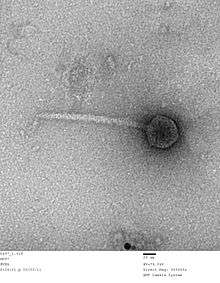Escherichia virus HK97
Escherichia virus HK97, often shortened to HK97, is a species of virus that infects Escherichia coli and related bacteria. It is named after Hong Kong (HK), where it was first located. HK97 has a double-stranded DNA genome.
| Escherichia virus HK97 | |
|---|---|
| Virus classification | |
| (unranked): | Virus |
| Realm: | Duplodnaviria |
| Kingdom: | Heunggongvirae |
| Phylum: | Uroviricota |
| Class: | Caudoviricetes |
| Order: | Caudovirales |
| Family: | Siphoviridae |
| Genus: | Hendrixvirus |
| Species: | Escherichia virus HK97 |
Assembly and maturation

The major capsid protein of HK97, called gp5, cross-links upon maturation to form a chain-mail like structure.[1] While DNA is being packaged into the capsid, the capsid expands by nearly 5 nm and changes from spherical to icosahedral in shape.
The HK97 assembly pathway begins with self-assembly of gp5 into pentamers and hexamers. A protease, called gp4, cleaves gp5 at its N-terminus. Attachment of a portal protein, gp3, coupled with conformational changes leads to the formation of a prohead, or procapsid, which is the precursor to the mature capsid.[2] A scaffolding protein is not required for capsid assembly.[3] However, studies on the effects of deleting the delta domain of the major capsid protein, or parts of it, indicate that it is essential for assembly.[4]
References
- Helgstrand, Charlotte; Wikoff, William R; Duda, Robert L; Hendrix, Roger W; Johnson, John E; Liljas, Lars (1 December 2003). "The Refined Structure of a Protein Catenane: The HK97 Bacteriophage Capsid at 3.44Å Resolution". Journal of Molecular Biology. 334 (5): 885–899. doi:10.1016/j.jmb.2003.09.035. PMID 14643655.
- Hendrix, RW; Johnson, JE (2012). "Bacteriophage HK97 capsid assembly and maturation". Advances in Experimental Medicine and Biology. 726: 351–63. doi:10.1007/978-1-4614-0980-9_15. ISBN 978-1-4614-0979-3. PMID 22297521.
- Duda RL, Martincic K, Hendrix RW (1995). "Genetic basis of bacteriophage HK97 prohead assembly". J. Mol. Biol. 247 (4): 636–47. doi:10.1006/jmbi.1994.0169. PMID 7723020.
- Oh B, Moyer CL, Hendrix RW, Duda RL (2014). "The delta domain of the HK97 major capsid protein is essential for assembly". Virology. 456-457: 171–8. doi:10.1016/j.virol.2014.03.022. PMC 4044616. PMID 24889236.